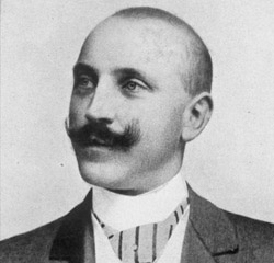Henri Rinck facts for kids
Henri Rinck (born January 10, 1870 – died February 17, 1952) was a French chess puzzle maker. He was especially known for creating "chess studies," which are like special chess puzzles. Many people see him as one of the most important early experts in this field.
Life Story
Henri Rinck was born in Lyon, France, on January 10, 1870. His family owned a brewing business there. He went to the Technical University of Munich in Germany and became a chemical engineer. Later, he worked as an assistant at the Faculty of Sciences in Lyon.
In 1897, he found a new way to clean and improve green vegetable oils. This method was used in Marseille, France, and later by olive oil factories in Spain. In 1900, he started his own factory in Badalona, Spain, and lived there with his family. He had to leave Spain for a short time during the Spanish Civil War but later returned.
His first chess endgame puzzles were published in 1902 in a German chess magazine called "Deutsche Schachzeitung". In 1909, he released his first book of puzzles, "150 fins de partie" (which means "150 Endgames"). He published more editions, including "300 fins de partie" in 1919 and "700 fins de partie" in 1927.
Henri Rinck was one of the most active chess puzzle creators. He published an amazing 1670 endgame studies! Out of these, 58 won first prize in puzzle competitions.
Rinck passed away in Badalona, Spain, on February 17, 1952. Just six days before he died, he received the first copy of his final collection, "1414 fins de partie." He asked to be buried with this book.
Chess Puzzles
| This section uses algebraic notation to describe chess moves. |
A "chess study" is a special chess puzzle. You are given a chess position, and your goal is to find the best moves to win or draw the game. Henri Rinck was famous for creating these challenging puzzles.
The puzzle below is one of Rinck's famous studies. It was once thought to be incorrect by some chess experts, but later, computers proved that Rinck's solution was right! This shows how clever and deep his puzzles were.
1414 fins de partie, nr. 126
Solution:
1. Qe4+ Ka6 2. Rh6+ Rf6 3. Qf5! wins
- If Black plays 1. ... Kb8, then White continues with 2. Rh8+ Kc7 3. Rh7 Rf2+ 4. Kc3 Rf3+ 5. Kd4(b4) and wins.
- If Black plays 1. ... Kb6, then White continues with 2. Rh6+ Kc5(a5,b5) 3. Qe5+ Qd5 4. Qc7+ and wins.
A chess expert named André Chéron believed this study was wrong. He thought Black could draw the game after 1. Qe4+ Ka6 2. Rh6+ Rf6 3. Qf5 Rxh6 4. Qxf7 Rc6!
However, later, powerful computer analysis showed that Rinck's study was indeed correct! Even after Black's best moves, White can still win the game.
See also
 In Spanish: Henri Rinck para niños
In Spanish: Henri Rinck para niños


